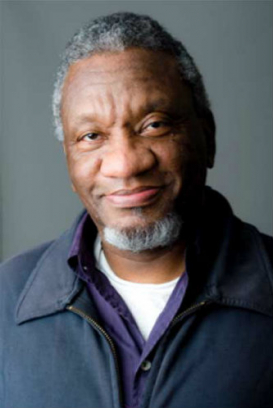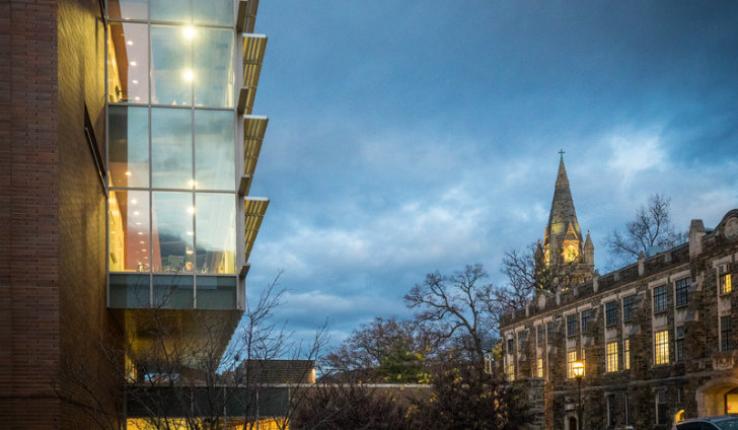Art As a Necessity
Donald Byrd uses modern dance as a platform for social action. His productions—with focuses ranging from post-9/11 America, police shootings of unarmed black men, violence against LGBTQ+ people, and America’s relationship with China—invite audience members to connect with their emotions related to societal issues and engage in conversations about them.
“Why would I choose to make work like this?” he asked attendees of an intimate talk in the Zoellner Arts Center Lower Gallery Monday evening (Oct. 8). “Why would I choose to do that as opposed to [creating] just a pretty, nice dance? Because if you make the pretty, nice dance, everybody comes to the pretty, nice dance. They applaud and ... smile and they go home. They forget about it. That’s why I choose to do those things. I want to contribute to people.”
Byrd, the artistic director of Seattle’s Spectrum Dance Theater, discussed “Using the Arts for Social Impact” at a public lecture the evening before he and the Spectrum presented “A Rap on Race” in Zoellner Arts Center’s Baker Hall. The dance/theater performance—co-created by Byrd and Pulitzer-nominated playwright and actress Anna Deavere Smith—is based on the 1970 public conversation on race between writer and social critic James Baldwin and anthropologist Margaret Mead.
During the talk, Byrd shared the events that led him to this point in his career, from his coming of age in the South during the Civil Rights Movement to creating the work he does today.
“My introduction to the arts was in fact an introduction to the world,” he said of his first artistic experiences: witnessing the Florida A&M marching band in a parade and attending a child-focused performance of the New York Philharmonic.
“It was the first time that I’ve ever been in a room where everybody was not all black,” he recalled of the New York Philharmonic performance. “[There were] black children there, white children there. The orchestra was all white. The instruments were unfamiliar to me. There were a lot of things that were unfamiliar to me. And so I got very excited about the experience. What I thought was, ‘The world is a fantastic, big place. And I’m so excited to be a part of it and I want to learn more about it. This big door opened. My life actually became about … stepping inside doors and experiences that were unfamiliar to me and welcoming me to those experiences.”
Later, as a freshman at Yale—-where he spent just one year before transferring to Tufts—Byrd faced more unfamiliar and eye-opening experiences.
“I didn’t know how to behave in that kind of environment: the formalities of New England, in an Ivy League situation,” he said. “I had never experienced an environment [like that]… So that was the first time that I realized that class was a motivator in terms of how people were going about their lives, how they interact with other people. So being there in the middle of 1967, I was getting a double whammy of class and race. And so what was important and significant about it was that I had to learn really quickly how to figure out what the rules were, and then how to operate inside that system, whether I believed in it or not, but just for survival.”
The arts, Byrd said, were important to him because he realized that they weren’t just for fun—they could be “a way of presenting issues to people that might have been difficult to hear otherwise.”
Bryd was living in Lower Manhattan on Sept. 11, 2001, and witnessing firsthand the terrorist attacks of that day led him to think deeply about America’s relationship with the world, he said. Americans, he thought, “were generally naive about our place in the world and about how people felt and thought about us in the world. It was a wakeup call.”
After moving to Seattle in 2002 to take on his current role with Spectrum, Byrd “started to think about how to engage communities to think more about not only what happens in our immediate communities, but also in a global sense. And then the question for me became: What role can the arts play in doing that? As an instigator, perhaps.”
The part of Spectrum’s mission that speaks to him most, Byrd said, was to “educate the community about dance as an art form and as a social/civic instrument.”
This might contrast, he said, with an audience’s existing notions about what dance is: merely pretty movement. Instead, he said, he wants his audience to experience what he wants to experience in a performance: “I want to have a dialogue with myself about everything that’s going on with myself right then: what I’m seeing, how I’m feeling about what I’m seeing. ... So it’s critical thinking that’s happening almost three-dimensionally on a lot of different planes and levels about what your experience is, so you’re alive on a lot of different levels simultaneously.”
Contributing to People and Art
The conversation between Baldwin and Mead, though it took place in 1970, is still relevant today, Byrd said.
“They seem quite prescient to me, that they would be thinking about that and talking about that then. And we are still in some ways talking about it now. Some of the language might have changed, but the basic concepts of it stayed the same. And it raises a question that comes up all the time among African-American people: Have things changed? Are they different from the way they were before?”
Byrd seeks to humanize societal issues, he said. Discussing his recent production, “Shot,” which addresses the shooting of unarmed black men by police, he said, “Are we able to look at something onstage that we recognize ourselves in what we’re seeing? That I can’t shoot you if I think you’re me. If you’re me, I’ll treat you really differently … and I think that’s really important that we have to learn to do that … that I look at you as another human being and I recognize myself in your existence and so I interact with you like you’re me.”
His main motivation, Byrd said, is community impact. His work, he said, is his contribution to people and to art, as well.
“I don't think of art as something that is trivial and that we can do without. I think of it as a necessity. It’s like an essential nutrient that we need for our spirit and our souls, and I want to be able to contribute that to people or to open that up as a possibility for them to receive that. And that drives everything that I do.”
A question-and-answer session followed Byrd’s lecture, with discussions on topics including Childish Gambino’s “This Is America,” the reaction of different communities to Martin Luther King Jr.’s message, and a more detailed discussion of “A Rap on Race.”
Byrd’s lecture and performance was presented by Zoellner Arts Center and Lehigh’s MLK Committee as part of the Race X series, which highlights the many ways that race intersects with other issues of societal importance.
Posted on:





